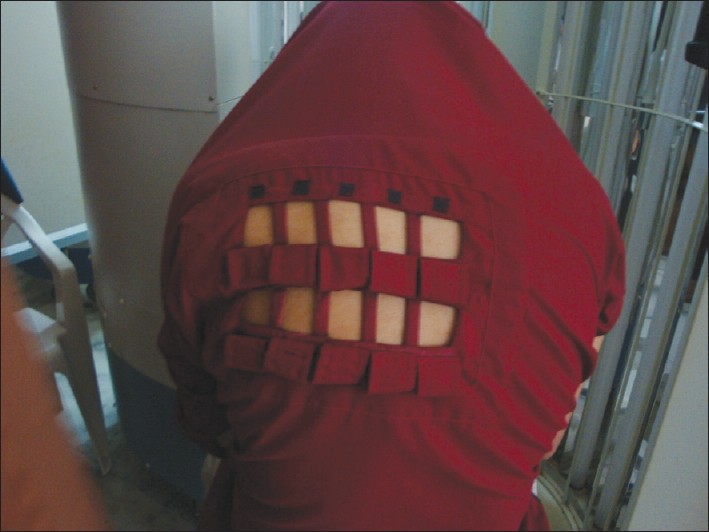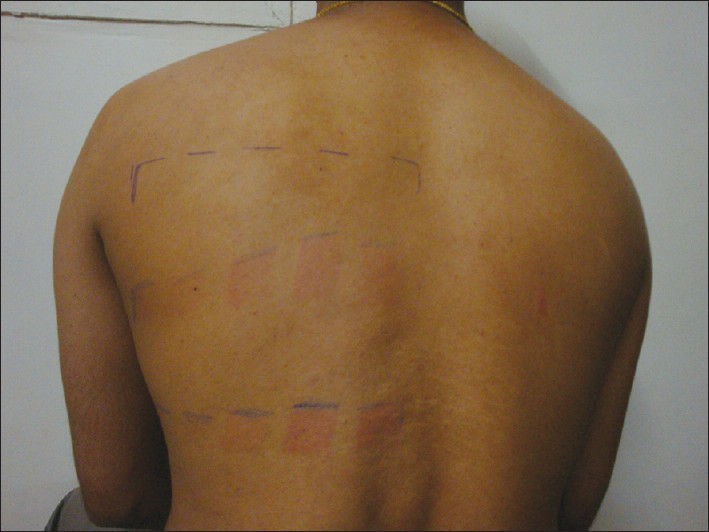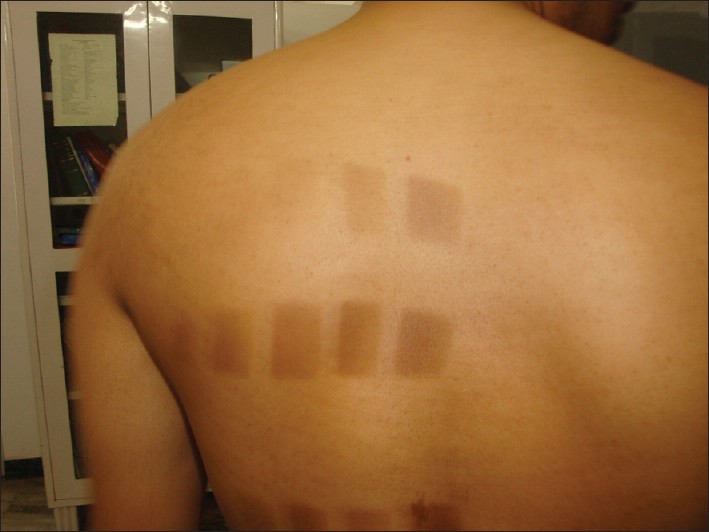Translate this page into:
Effect of turmeric in lowering the minimal erythema dose and minimal pigmentary dose following broad band ultraviolet - B exposure
Correspondence Address:
M Kumaresan
Department of Dermatology, PSG Hospitals, Coimbatore, Tamil Nadu
India
| How to cite this article: Kumaresan M, Srinivas C R. Effect of turmeric in lowering the minimal erythema dose and minimal pigmentary dose following broad band ultraviolet - B exposure. Indian J Dermatol Venereol Leprol 2011;77:713-714 |
Sir,
Turmeric (Curcuma longa) is botanically related to ginger (Zingiberaceae family), which had been used in Ayurveda, Unani, and Siddha medicine as home remedy for various diseases. Woman in India apply turmeric before taking bath. It is also considered as auspicious and is a part of religious rituals. We conducted this study to determine the photoprotective properties of topical and oral turmeric against broad band ultraviolet - B (BB-UVB). Because BB-UVB mimics the natural spectrum of sunlight and the narrow band ultraviolet - B (NB-UVB) is used only for therapeutic purpose, we decided to use BB-UVB in this study.
After ethical committee clearance, we enrolled 30 volunteers with Fitzpatrick skin type III, IV. Study period was from June 2010 to December 2010. Minimal erythema dose (MED) to BB-UVB was determined by standard method [Figure - 1]. Back was chosen for testing, as it is a covered area and less likely to be influenced by environmental UV exposure. Just perceptible erythema visible to the naked eye was taken as MED [Figure - 2]. Volunteers were followed up for 7 days after MED determination to determine the minimal pigmentary dose (MPiD) to BB-UVB. MPiD for the purpose of this study is defined as the least amount of BB-UVB required to elicit a well demarcated area of pigmentation following exposure to BB-UVB [Figure - 3]. Fresh turmeric powder was obtained and turmeric paste compounded each time by adding 7 ml distilled water to 2 g of turmeric powder in pestle and mortar. The paste was applied in a uniform thin layer (10 × 10 cm; 2 mg/cm 2 ) over back of volunteer and allowed to dry. This was repeated for 7 days. At the end of 7 days the volunteers were exposed to BB-UVB on the site where turmeric paste was applied. The MED and MPiD were calculated as described earlier and compared with the baseline values. Same volunteers were recruited 1 month later and were asked to take 2 g of turmeric powder in 100 ml warm milk once daily for a period of 7 days. At the end of 7 days they were subjected to MED determination and MPiD evaluation as described above and compared with the baseline values and with those following topical turmeric.
 |
| Figure 1: Template for minimal erythema dose determination |
 |
| Figure 2: Minimal erythema dose |
 |
| Figure 3: Minimal pigmentary dose |
Among the 30 volunteers, 21 were males and 9 were females. The age group ranges from 21 to 67 years, with a mean age of 33.83. The mean baseline MED was 11.03 mj [standard deviation (SD) 2.5661] and mean MPiD was 11.86 mj (SD 2.7384). After topical turmeric application, the mean MED was 11.66 mj (SD 3.0663) and mean MPiD was 13.03 mj (SD 3.0792). There was 0.63 mj raise in MED after topical turmeric and 1.17 mj raise in MPiD after topical turmeric. After oral turmeric, the mean MED was 11.46 mj (SD 3.1375) and mean MPiD was 13.13 mj (SD 2.9912). There was 0.43 mj raise in MED after oral turmeric and 1.27 mj raise in MPiD after oral turmeric. Although there was raise in MED and MPiD following topical and oral turmeric, this difference was not statistically significant (ANOVA test CV 4.9% and 2.28%). Four (13.345%) patients had lower MED after topical and oral turmeric.
There are reports of nutritional photoprotection with functional foods or supplements such as vitamins, beta-carotene, green tea, and lycopene. [1],[2] In this study, we observed that the MED and MPiD increased in 26 (86.66%) patients after oral and topical turmeric application, thus suggesting the photoprotective action. However, its photosensitizing property as described by Kelly et al. [3] was seen in 4 (13.34%) patients. Photoprotective action was seen in more number of patients than the photosensitivity. Because turmeric has many chemicals and the specific chemical responsible for the photoprotective and photosensitizing action has not been isolated, further studies with specific components in turmeric may help in identifying the chemical responsible for photoprotective and photosensitizing action.
We had earlier reported allergic contact dermatitis to turmeric [4] ; turmeric does not reduce the facial hair growth and it does not have any protection against acne when applied topically. [5] Indian women apply turmeric paste all over the body based on the belief that it removes the unwanted hairs, reduces acne, and improves the complexion. Our study has shown that turmeric as available does not offer significant photoprotection nor does it prevent pigmentation against BB-UVB.
| 1. |
Eberlein-König B, Ring J. Relevance of vitamins C and E in cutaneous photoprotection. J Cosmet Dermatol 2005;4:4-9.
[Google Scholar]
|
| 2. |
Fuchs J, Kern H. Modulation of UV-light-induced skin inflammation by D-alpha-tocopherol and L-ascorbic acid: A clinical study using solar simulated radiation. Free Radic Biol Med 1998;25:1006-12.
[Google Scholar]
|
| 3. |
Kelly MR, Xu J, Alexander KE, Loo G. Disparate effects of similar phenolic phytochemicals as inhibitors of oxidative damage to cellular DNA. Mutat Res 2001;485:309-18.
[Google Scholar]
|
| 4. |
Lal S, Srinivas CR. Allergic contact dermatitis to turmeric in kumkum. Indian J Dermatol 2006;51:200-1.
[Google Scholar]
|
| 5. |
Shaffrathul JH, Karthick PS, Rai R, Srinivas CR. Turmeric: Role in hypertrichosis and acne. Indian J Dermatol 2007;52:116.
[Google Scholar]
|
Fulltext Views
4,515
PDF downloads
1,409





